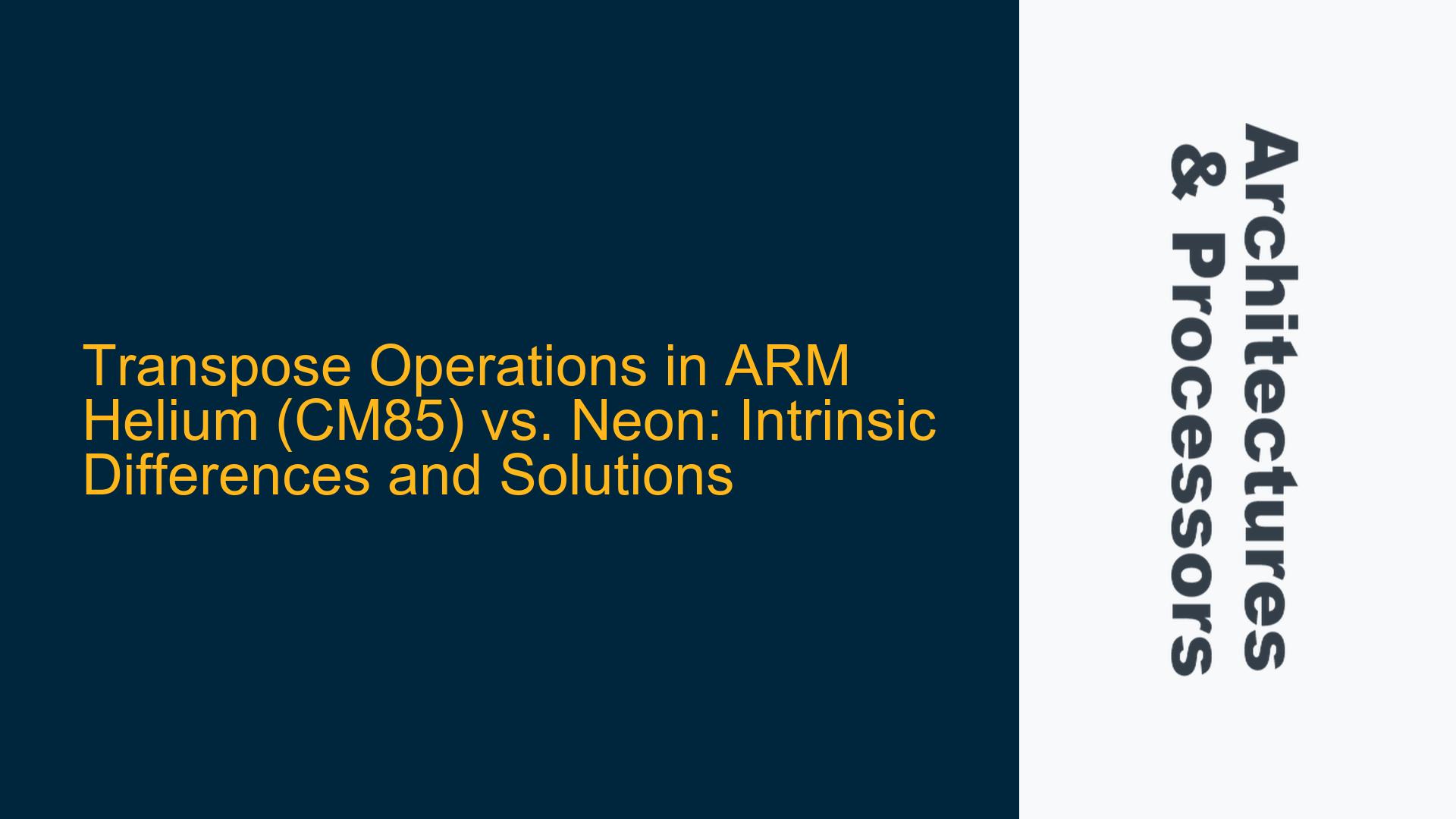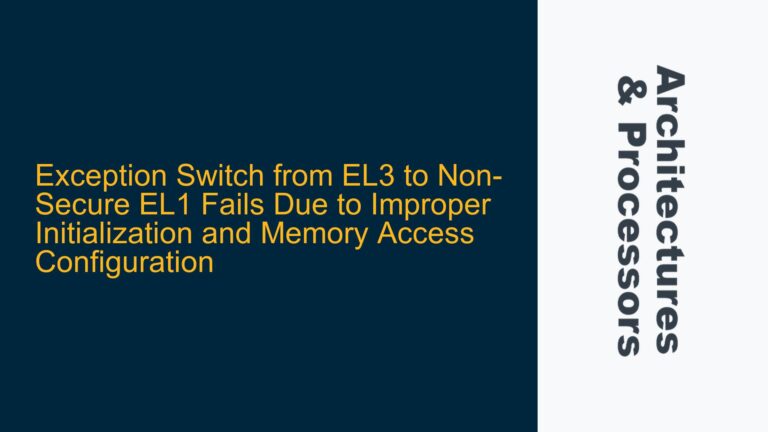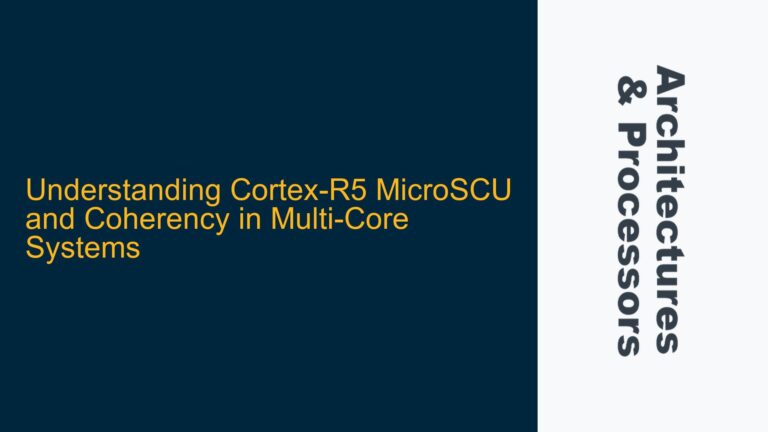ARM Helium (CM85) Transpose Intrinsic Absence Compared to Neon
The ARM Cortex-M85 processor, equipped with the Helium (M-Profile Vector Extension, MVE) instruction set, introduces significant enhancements for vector processing compared to its predecessors. However, developers transitioning from Neon-based architectures (e.g., Cortex-A series) to Helium may encounter challenges due to differences in intrinsic support. One such challenge is the absence of direct transpose intrinsics like vtrn_u32 or vtrn_u8 in Helium, which are readily available in Neon. This discrepancy arises from the architectural differences between Helium and Neon, as Helium is optimized for microcontroller-class workloads with a focus on power efficiency and deterministic performance, whereas Neon targets high-performance applications with broader SIMD capabilities.
The transpose operation is a fundamental matrix manipulation technique used in various algorithms, such as image processing, linear algebra, and machine learning. In Neon, the vtrn intrinsics simplify the process of swapping elements between vectors to achieve transposition. However, Helium does not provide direct equivalents, requiring developers to implement transpose operations using alternative methods. This issue is particularly relevant when porting code from Neon to Helium, as the lack of direct intrinsics can lead to performance bottlenecks or incorrect implementations if not addressed properly.
Architectural Differences and Missing Intrinsics in Helium
The absence of transpose-specific intrinsics in Helium stems from the architectural design goals of the MVE. Helium is tailored for embedded systems, where resource constraints and power efficiency are critical. Unlike Neon, which supports a wide range of SIMD operations for general-purpose computing, Helium focuses on providing a subset of operations that are most beneficial for microcontroller applications. This design choice results in a leaner instruction set, but it also means that certain operations, such as direct matrix transposition, must be implemented using lower-level primitives.
In Neon, the vtrn intrinsics are designed to handle element-wise swapping between vectors efficiently. For example, vtrn_u8 swaps 8-bit elements between two vectors, while vtrn_u32 handles 32-bit elements. These intrinsics abstract the underlying hardware details, enabling developers to write concise and optimized code. In contrast, Helium requires developers to manually implement transpose operations using available intrinsics, such as vector load/store operations, element shuffling, and interleaving. This approach increases code complexity but provides greater flexibility in tailoring the implementation to specific use cases.
Implementing Transpose Operations in Helium Using Available Intrinsics
To perform transpose operations in Helium, developers must leverage the available intrinsics to achieve the desired functionality. The process involves breaking down the transpose operation into smaller steps and using Helium’s vector manipulation capabilities to execute these steps efficiently. Below is a detailed guide on implementing transpose operations for common data types, such as 8-bit and 32-bit elements, using Helium intrinsics.
8-Bit Matrix Transposition
For 8-bit matrices, the transpose operation can be implemented using a combination of vector load, store, and element shuffling intrinsics. The following steps outline the process:
- Load the input matrix into vectors: Use the
vldrbqintrinsic to load the matrix rows into Helium vectors. For a 4×4 matrix, this results in four vectors, each containing a row of the matrix. - Rearrange elements within vectors: Use the
vrevandvshuffintrinsics to rearrange elements within the vectors. This step involves swapping elements between vectors to achieve the desired transposition. - Store the transposed matrix: Use the
vstrbqintrinsic to store the transposed vectors back into memory.
The following code snippet demonstrates the implementation:
#include <arm_mve.h>
void transpose_8bit(uint8_t *input, uint8_t *output) {
// Load rows into vectors
uint8x16_t row0 = vldrbq_u8(input);
uint8x16_t row1 = vldrbq_u8(input + 16);
uint8x16_t row2 = vldrbq_u8(input + 32);
uint8x16_t row3 = vldrbq_u8(input + 48);
// Rearrange elements
uint8x16_t temp0 = vshuffq_u8(row0, row1, 0x10);
uint8x16_t temp1 = vshuffq_u8(row0, row1, 0x32);
uint8x16_t temp2 = vshuffq_u8(row2, row3, 0x10);
uint8x16_t temp3 = vshuffq_u8(row2, row3, 0x32);
// Store transposed matrix
vstrbq_u8(output, temp0);
vstrbq_u8(output + 16, temp1);
vstrbq_u8(output + 32, temp2);
vstrbq_u8(output + 48, temp3);
}
32-Bit Matrix Transposition
For 32-bit matrices, the transpose operation requires a different approach due to the larger element size. The following steps outline the process:
- Load the input matrix into vectors: Use the
vldrwqintrinsic to load the matrix rows into Helium vectors. For a 4×4 matrix, this results in four vectors, each containing a row of the matrix. - Rearrange elements between vectors: Use the
vzipandvuzpintrinsics to rearrange elements between vectors. This step involves interleaving and deinterleaving elements to achieve the desired transposition. - Store the transposed matrix: Use the
vstrwqintrinsic to store the transposed vectors back into memory.
The following code snippet demonstrates the implementation:
#include <arm_mve.h>
void transpose_32bit(uint32_t *input, uint32_t *output) {
// Load rows into vectors
uint32x4_t row0 = vldrwq_u32(input);
uint32x4_t row1 = vldrwq_u32(input + 4);
uint32x4_t row2 = vldrwq_u32(input + 8);
uint32x4_t row3 = vldrwq_u32(input + 12);
// Rearrange elements
uint32x4x2_t temp0 = vzipq_u32(row0, row2);
uint32x4x2_t temp1 = vzipq_u32(row1, row3);
uint32x4x2_t temp2 = vuzpq_u32(temp0.val[0], temp1.val[0]);
uint32x4x2_t temp3 = vuzpq_u32(temp0.val[1], temp1.val[1]);
// Store transposed matrix
vstrwq_u32(output, temp2.val[0]);
vstrwq_u32(output + 4, temp2.val[1]);
vstrwq_u32(output + 8, temp3.val[0]);
vstrwq_u32(output + 12, temp3.val[1]);
}
Performance Considerations and Optimizations
When implementing transpose operations in Helium, performance is a critical consideration. The following strategies can help optimize the implementation:
- Minimize memory accesses: Use vector load and store operations efficiently to reduce the number of memory accesses. Grouping multiple operations into a single load/store can improve performance.
- Leverage vector shuffling: Use Helium’s vector shuffling intrinsics to rearrange elements within vectors. This approach minimizes the need for intermediate storage and reduces latency.
- Pipeline operations: Arrange the sequence of operations to maximize instruction-level parallelism. This can be achieved by overlapping independent operations and minimizing dependencies between instructions.
By carefully designing the implementation and leveraging Helium’s capabilities, developers can achieve efficient transpose operations that meet the performance requirements of their applications.
Conclusion
While ARM Helium (CM85) does not provide direct intrinsics for transpose operations like Neon, developers can implement these operations using available intrinsics. By understanding the architectural differences between Helium and Neon and leveraging Helium’s vector manipulation capabilities, developers can achieve efficient and optimized transpose operations. The provided code snippets and optimization strategies serve as a starting point for implementing transpose operations in Helium, enabling developers to port code from Neon to Helium effectively.






